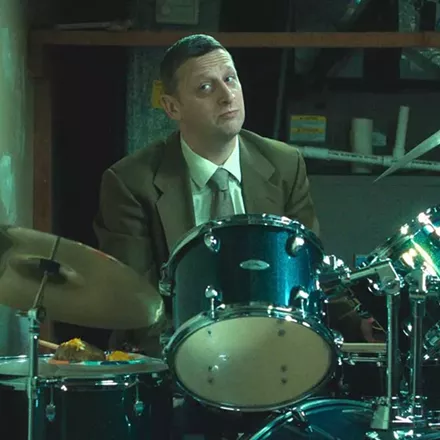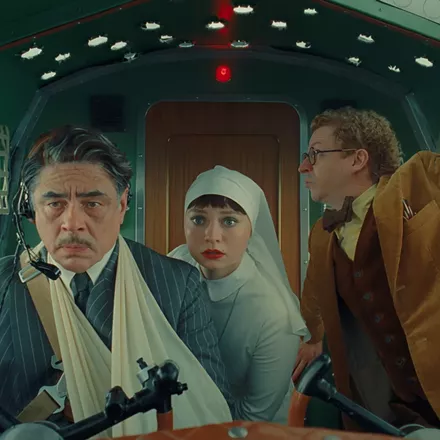Talking 'Bout Her Generation
The Worst Person in the World compassionately captures a Millennial figuring out her life path.
By Scott Renshaw @scottrenshawJulie (Renate Reinsve)—the protagonist of Joachim Trier's The Worst Person in the World—is not the person about whom the title's sentiment is expressed within the film itself. That comes in a piece of omniscient voice-over narration describing another character—more specifically, describing a way that he feels about himself. But he isn't the worst person in the world, either, and neither is any other person muddling her or his way through life in this story.
Trier might, however, have found the perfect title for a deeply compassionate portrayal of people living in an era of hyperbolic nomenclature and existential dread. As we follow Julie over several years of her life in her late 20s and early 30s, we watch someone trying to figure herself out, relative to expectations about what she should already have figured out about herself. An entire generation needs to hear what Trier is shouting in The Worst Person in the World: It's okay not to know who you are until you actually know who you are.
Structured (as the opening credits helpfully explain) in twelve chapters with a prologue and epilogue, The Worst Person in the World introduces us to Julie while she's a student preparing for a career in medicine. Except she soon realizes that she's more interested in the mind than the body, and switches gears to study psychology. Then psychology, too, feels like the wrong path, and she pivots to an interest in photography, while taking a retail job in a bookstore. With every change in direction for Julie comes a new hair color and style, conditioning us to the assumption that Julie is one of those flaky, hopelessly failing-to-launch Millennials.
We similarly see her bouncing between romantic partners, before seeming to settle down with comic-book artist Aksel (Anders Danielsen Lie). Aksel, however, is more than a decade older, and a bit more serious, than Julie, so an encounter with a random guy named Eivind (Herbert Nordrum), whom she meets while crashing a wedding reception, takes on a magical glow. Oh, that hopeless Julie. Will she ever be satisfied with what she has?
It's a testament to how beautifully Trier and Reinsve craft Julie's character that she never comes off like a ditzy object of scorn or pity. Reinsve's performance doesn't only come to life when it's conveying Julie's impulsiveness, but also when she's in repose, like a complex facial expression that Trier captures during a moment when she's walking home from a party. That depth of character extends to all the supporting players as well, as The Worst Person in the World refuses to oversimplify anyone. As easy as it would have been to reduce Aksel to the kind of guy who laments that his trademark cat character has been artistically butchered for a movie version because his little cat anus has been erased, or who gets defensive about the sexism in his work, Trier also allows Aksel some of the film's most melancholy observations later on.
The episodic structure fits perfectly for a story about someone whose life perpetually feels like a series of false starts, but it also allows Trier the chance for some delightful formal playfulness. While most of the story unfolds fairly naturalistically, we also get a crazy sequence involving Julie's trip on hallucinogenic mushrooms, and a fantasy in which she imagines what she would do with a day where she could stop time. It also allows for sequences that showcase some of the year's most emotionally insightful filmmaking, particularly the chapter involving Julie's first meeting with Eivind, and the way they tiptoe around the boundaries of what constitutes "cheating."
There's also a moment that might be easy to overlook, yet which feels like the key to unlocking Julie's journey. At the dinner celebrating Julie's 30th birthday, the narrator begins noting what had already happened in the lives of Julie's mother, grandmother and other forebears by their 30th birthdays, extending back several generations to the point where "the life expectancy was 35 years old." It's this generational shift—from a world where women of Julie's age had their lives already defined for them, to one where almost too many paths are open—that The Worst Person in the World treats with such openness and respect. There's no one right way to reach the point where you know what your life should look like, and taking a few extra years to get there should never leave someone feeling like the worst person in the world.
More by Scott Renshaw
-
Writer of the Lost Oligarch
The Phoenician Scheme gets both silly and serious about what makes rich dickheads tick.
- Jun 4, 2025
-
Film Reviews: New Releases for May 30
Karate Kid Legends, Bring Her Back, Jane Austen Wrecked My Life, Bad Shabbos, Tornado
- May 29, 2025
-
JANE AUSTEN WRECKED MY LIFE, BRING HER BACK, June 2025 Special Screenings
Two new releases, plus SLFS Summer Showdown, Wild & Scenic Festival and more.
- May 28, 2025
- More »
Latest in Film Reviews
Readers also liked…
-
Sundance 2025 wrap-up plus February special screenings
Uncertainty about the future location shifts focus away from the movies
- Feb 5, 2025










